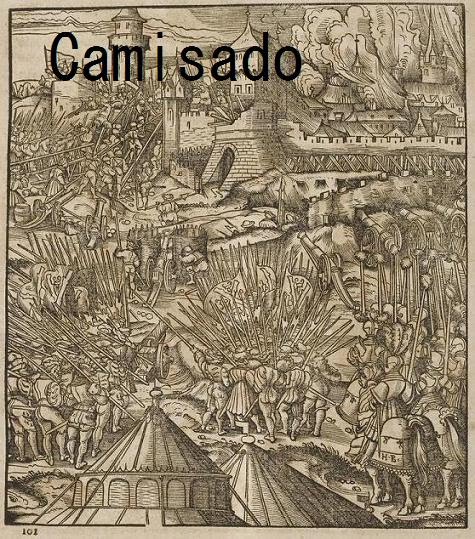I have been slowly working through the Steel Fist 16th Century Foot Knights, having backed the Kickstarter last year. The idea is that each one will be the focus of their own base of supporting figures and I have already used two of them in this way as command bases. The chaps shown here are destined to lead bases of tightly packed attacking Landsknechts into battle but before I home them permanently on such bases I couldn't resist getting some shots of them dueling with each other.
When I first saw these figures the poses instantly reminded me of the prints from Maximilian's Freydal. His tournament book that painstakingly recreates all kinds of permutations of mounted and dismounted sporting combat in the early 16th Century. They also reminded me of the two scenes shown below from his Weisskunig (this blog can't go for a few months without some Weisskunig prints!). Maybe they aren't using longswords but one does have similarly bizarre pointed head attire to the miniature with a "grotesque" helmet. In the prints case I think they may be metal attachments rather than feathers. My scenes in miniature are hardly an exact replication but you get the idea. I bought the figures as part of a Kickstarter but they are now available here: http://www.steelfistminiatures.com/products/16th_century_knights.
 |
| Poleaxe Combat as depicted in Der Weisskunig c.1516 |
 |
| Spear Combat from Der Weisskunig c.1516 |
Historical European Martial Arts have never really been my thing but I have dabbled in a few "Fechtbücher" in the past. I can recommend the 15th Century works of Hans Talhoffer, https://www.amazon.co.uk/Medieval-Combat-Fifteenth-Century-Swordfighting-Close-Quarter/dp/1848327706/ref=pd_bxgy_14_img_2?_encoding=UTF8&psc=1&refRID=05DHPK04H17EK5GR9P75, and Fiore dei Liberi (which is Italian so not really a fechtbuch!), https://www.amazon.co.uk/d/Books/Knightly-Art-Battle-Mondschein/1606060767/ref=pd_sim_14_5?_encoding=UTF8&psc=1&refRID=9MRPJ3QBS8PWK5GVYV6W as worth a look if you do have a beginners interest. When I first encountered these works I found it quite an eye opener how different the armed combat of the later medieval period really was compared to what is seen in film and TV. Of course there are lots of caveats as to how you approach these works. Some fighting techniques are for specific judicial duels. Some are for armoured combat only. Even when these things are made clear you realise there was a whole culture of "martial arts" that has now long died. They were often extremely brutal and also more physical than the later styles of sword combat we are used to in the 21st century. It's surprising how much wrestling and grappling style moves feature, as well as surprises such as launching the sword at an opponent like a dart!
If you can get through the really tedious chapter that discusses how in later centuries they tried to apply maths to fencing techniques then the Martial Arts of Renaissance Europe is worth a read: https://www.amazon.co.uk/Martial-Arts-Renaissance-Europe/dp/0300083521/ref=sr_1_1?s=books&ie=UTF8&qid=1497380372&sr=1-1&keywords=renaissance+martial+arts. I was particularly amused by the jousting section. Fight Masters would go into great detail on how to hit an opponent in all sorts of locations and to demonstrate various levels of skill and flair with the lance. In contrast the advice for real war was always very simple: just aim for the other riders horse! I would also recommend the Scholagladiatoria channel on Youtube, https://www.youtube.com/user/scholagladiatoria. This channel has lots of videos on renaissance weaponry and how it was used and what the symbolism of it was. There are some great videos on there in the Wallace Collection with Tobias Capwell as well as an in depth discussion of an early 15th Century Tomb effigy and the armour it represents: https://www.youtube.com/watch?v=5tgLeMS30j8.
That's probably enough rambling for now. Hopefully I will get these Men at Arms based up with the Landsknechts soon, I am about half way through painting the halberdiers that will be supporting them. I am also working on a few more casualty bases, they may be a bit grisly but I have enjoyed working on them and they are very useful on the gaming table.
 |
| 16th Century Men at Arms by Steel Fist Miniatures |
 |
| Men at Arms in early 16th Century Harness, one with a "Grotesque" visor. |
 |
| The Landsknechts look on as they duel |








